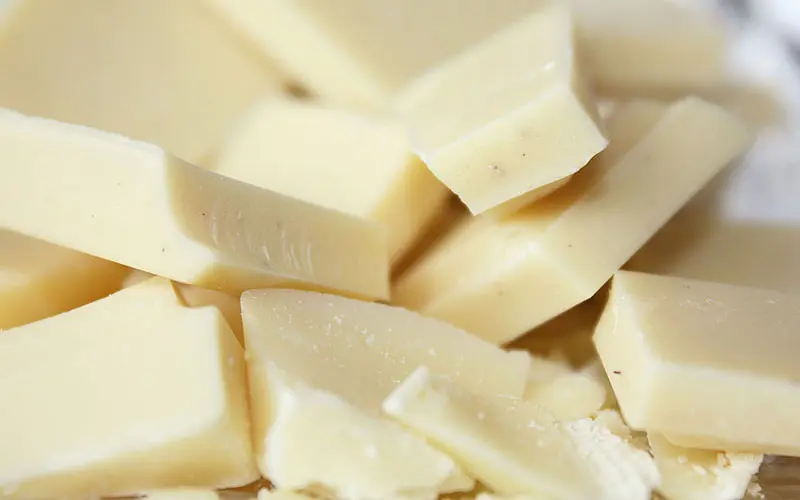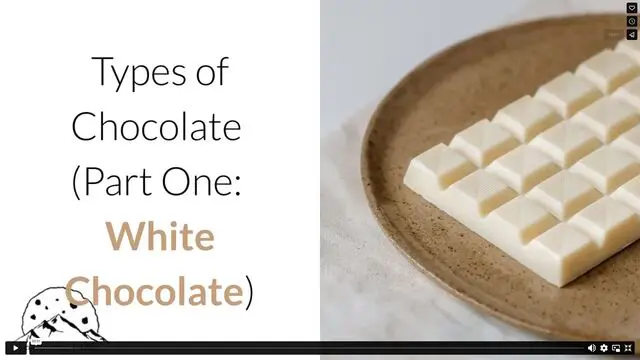Few things cause more debate among chocolate lovers than their feelings regarding white chocolate. Take a moment to think about your opinions on the matter. Do you love it? Do you hate it? Are you completely indifferent? While a few people genuinely don’t care one way or another about white chocolate, most other people are pretty polarized.
For people who love it, it’s usually the ultra-smooth mouthfeel and sweetness that they find so appealing. White chocolate lovers also claim that white chocolate is the perfect canvas to showcase more subtle and exciting flavor combinations that darker chocolate would overpower.
The people who hate it cite white chocolate’s excessive sweetness as the confection’s major downfall. Since white chocolate doesn’t have any chocolate liquor (the ground of nibs that provide chocolate’s distinct dark color and alluring smell) as part of its mass, chocolatiers often use sweeteners and other fillers to make up the difference. Those additions can take away from the “naturalness” that you can find in other forms of darker chocolate. Since the vast majority of white chocolate is some kind of fat, it can also leave a greasy or oily coating on your tongue, which is another huge turnoff for some people.
So who’s right?
At day’s end, it’s a matter of personal preference, but there may be some people out there who are willing to soften their opinion toward white chocolate with a bit more information. We’re here to do that today as we dive into the world of white chocolate.

(caja / pixabay)
History
White chocolate hasn’t been around for very long – not even a hundred years! Allegedly, in the 1930s, Nestle came up with the idea to use up excess cocoa butter by mixing it up without the chocolate liquor. It hit the U.S. market in the late 1940s, and by the 1990s, chocolate makers were mixing white chocolate with all kinds of new flavors.
The Chocolate/Not Chocolate Debate
In the early 2000s, the FDA decided to officially define what “chocolate” meant in the culinary world. This set of standards created a distinction between what is technically chocolate and what is chocolate flavored. According to the FDA, white chocolate is considered chocolate if it meets the following guidelines:
- No less than 20% cacao fat (cocoa butter)
- No less than 3.5% milkfat
- No less than 14% total milk solids
- No more than 55% sweetener
Many people will argue that because there aren’t any cocoa solids (aka chocolate liquor), white chocolate can’t be actual chocolate, but at least the FDA disagrees.
A Change Among Chocolatiers
For many years, chocolate manufacturers have tried to cut costs when they were making white chocolate. Since white chocolate is primarily fat anyway, sometimes the chocolate makers would substitute some of the cocoa butter for other, less expensive fats and oils. Additionally, many chocolate makers use cocoa butter that has been bleached and/or deodorized. The bleaching makes the chocolate bar a much brighter white, and the deodorization process removes almost all of the cocoa butter’s natural cocoa-y aroma. This process yields a somewhat flat flavor dimension that could then be heavily flavored (usually with vanilla).
However, as more and more craft chocolate shops are popping up, chocolatiers are starting to swing back toward white chocolate au naturel. They’re staying away from bleached or deodorized white chocolate that is stuffed with fillers and heading back to the basics: cocoa butter, sugar, milk products, emulsifier, and (sometimes) vanilla. From there, they’re making all kinds of new flavor combinations. Some of the most exciting (and perhaps a little strange) pairings include:
- Matcha green tea
- Blackberries, raspberries, blueberries
- Rosemary
- Almonds and broccoli
- Mango, chile, and lime
- Turmeric
- Beer hops
- Thai curry shrimp
- Pistachio
- Kale and mustard
Things to Do with White Chocolate
White chocolate is very versatile in your everyday cooking and baking. Probably the first thing that comes to your mind is to make cookies with white chocolate chips. Keep in mind that most of the white chocolate chips you find at the store often have added ingredients that help them keep their small, pointed shape during the baking process. Because of the high volume of cocoa butter in white chocolate, it has a relatively low melting point (only about 104 degrees), so baking chips need a little help from extra ingredients to keep their shape and texture in the oven. If you like that flavor and texture profile, we say, go for it! Our gourmet White Chocolate Pecan cookie, for instance, makes the perfect thinking of you gift for loved ones who live far away. Otherwise, you can always chop up a white chocolate bar to get some larger, softer chunks of white chocolate in your cookies.
Additionally, white chocolate melts really well in fondue or for dipping strawberries. You can caramelize it to form a delicious treat called golden or blonde chocolate. It can be tricky to temper correctly, but when you temper it well, it works great for coating bonbons with soft fillings (example: creams and caramels). It also adds a wonderful, full texture and taste to mousse, ice cream, ganache, and cake. Just keep in mind that you may have to adjust the amount of fat and sugar in your confections to accommodate for the extra fat and sugar in the white chocolate.
White chocolate may get a bad rap from a lot of people, but it can be an extremely versatile addition to your kitchen. When you play to its strengths and use high-quality white chocolate, even the staunchest of supporters in the anti-white-chocolate club may find themselves with a happy smile after biting into a piece of white chocolate.
Video

